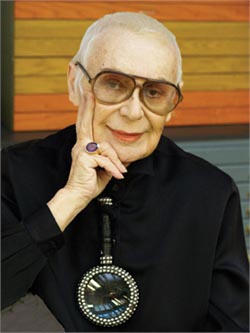June Wayne A Lifetime of Lithography

June Wayne’s life and her work spans the decades from World War II to the present. Her art that includes paintings, three dimensional work and tapestries is remarkable in that as she moved into new forms of creative expression, she was the first, she was the one that opened the portal through which other artists followed. She is our Number One Hollywood Art Treasure.
In the Los Angeles Printmaking Society’s catalog of its current exhibit at the Los Angeles Municipal Art Gallery, artist/curator Mary Sherwood writes, “It is impossible to imagine the world of printmaking today without June Wayne, the founder (and creator) of Tamarind Lithography Workshop. Her stature in resurrecting the art of lithography is well documented and always a riveting story…. But her scope and influence on the larger art scene in LA is as yet uncalculated and often missed in other appreciations of her contributions. What would Los Angeles have been like without the influx of artists in Tamarind’s artist grantee and apprentice programs that gave such a wealth of talent to the fine art of the print, challenging new dimensions and new techniques, and establishing the role of printmaking solidly in the DNA of the Los Angeles art scene?”
June Wayne established the Tamarind Studio to recognize and advance the art of printmaking in Hollywood. Through her trailblazing efforts and the success of the Tamarind, printmaking and lithography have assumed their rightful place in the world of art. Tamarind Workshop moved to the University of New Mexico in 1973, but not June Wayne.
Having passed her 90th birthday, June Wayne shows no sign of slowing down. Her outlook and energy belie the years and her spirit is as fresh as a spring breeze.
June is but one of the stars in Hollywood’s crown, but in terms of impact and world recognition in the art world, she is without peer. Her work spans generations and her passion for art and its impact – especially on the young – has not dimmed. She is credited for reigniting lithography and influencing such noted artists as Zammitt, Johnston, Everts, Nevelson, O’Keefe, Albers, Tamayo and more.
Recently, I visited with June on Tamarind Avenue. Her home and studio, nondescript from the exterior, is a peaceful oasis steps from the hustle and bustle of mid-Hollywood Santa Monica Blvd. The main building, designed by Wayne in the mid-60’s features large north facing opaque factory-style windows. Loft like in its spaciousness, there is no doubt that this is indeed a very special place.
As I listen to the diminutive artist, our conversation is free form to get a sense of her essence as one of this country’s most influential artists. We discuss her neighborhood and its changes. June did not seek solace or peace in the New Mexico desert or a lofty hillside above the city. She stayed in the working class, quasi industrial, neighborhood just off of Santa Monica Boulevard where she continues making her art.
Although the body of her work is not easily categorized, her name and her ingenuity will forever be linked to printmaking. It was her realization that the printmaking art in the United States was fading into possible oblivion. So she designed a studio that would provide structure, discipline and freedom to create to a diverse and influential corps of artists. During my visit, she spoke about “designing” Tamarind – it is not only the physical, but the philosophical design that made the lasting impact.
June arrived in Los Angeles during the war years and, like many artists, was employed in the aircraft industry interpreting blue prints for fabrication by metalworkers. It wasn’t long before these artists connected beyond the factories and were introduced to other artists.
Asked about how California influenced her, June responded, “ I think of this place as if we were talking about “milles feuilles” (french pastries)—layer upon layer upon layer of delicacies of different flavors and textures – because we came from other parts of the world either as refugees or as searchers for the golden chalice – certainly for creative reasons. Out here there was space and with space you could have privacy and the peculiarities that make an individual.” She continued. ”There was room enough for all these possibilities without a tight sense of control so the extraordinary quality of freedom was encouraged by the space, by a kind of nomadic aspect in the personality of people. “
The visit was coming to an end and June talked about the future.
“Everywhere I turn still there are big questions, things that can be done, should be done, and are possible to do now that were not possible even a few years ago.” And she has concerns. “I see a great creative crisis in the making affecting not only the individual but language, thought patterns, education, the loss of the subtly of speech and what it does for the enrichment of life. But solutions are designable – just as I designed Tamarind.”
Sitting in her studio, as the afternoon light dims, June Wayne’s light is still shining bright. DH
Note: One of June Wayne’s lithographs is included in “Connections: 1962-1973” the companion exhibit to the 20th Annual Los Angeles Printmaking Society’s show through January 3 .